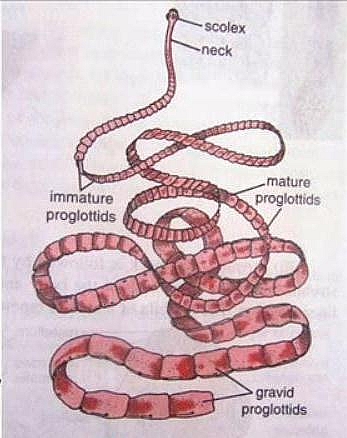Taenia solium is the pork tapeworm that causes two types of diseases in humans: Taeniasis caused by the adult Taenia solium and Cysticercosis caused by the larvae. Taenia solium is a Platyhelminthes that belongs to the class of Cestodes; this parasite can grow to about 2 to 8 meters in length. The pork tapeworm had two parts: the head called the scolex and the body that is segmented into parts called the proglottids. Adult Taenia solium can be found in the intestine of humans where they shed their eggs and proglottids daily.
Table of Contents
Transmission of Taenia solium infection
Taenia solium can be transmitted by ingestion of pork that has been infected with the larvae. It can also be transmitted by taking contaminated food or water containing the eggs of the tapeworm.
Taenia solium Morphology and Characteristics
Taenia solium has a head called the scolex; the scolex has four suckers and a circle of hooks. There are segments that join to form the length of Taenia solium these segments are called proglottids and each can carry out reproduction, which means that cutting a segment can still produce eggs and multiply. Each proglottid has about 5 to 10 primary uterine branches. The eggs of Taenia solium are similar microscopically to that of Taenia saginata and Echinococcus species. The larvae of Taenia solium are called Cysticerci and each has a small bladder filled with fluid and an invaginated scolex.
Taenia solium attaches to the intestines by using suckers, hooks, or sucking grooves. This tapeworm grows by adding new proglottids from the germinal center that is close to the head (scolex) and produces eggs from the oldest proglottids at the distal end.
Taenia solium Life cycle
- The eggs of the pork tapeworm (Taenia solium) are released in the stool
- Eggs are then ingested when pigs graze on contaminated grasses; the pigs serve as the intermediate hosts by ingesting the eggs which then develop into larvae. Humans can also serve as the intermediate host when they ingest the eggs in food or water that is contaminated with feces containing the eggs.
- Ingested eggs then develop into embryos known as Oncospheres in the intestine of the pig. Each embryo has six hooks that help them attach to the intestinal wall. These embryos then burrow into blood vessels where they are taken to the muscles of the pigs.
- In the pig’s muscle tissue, the embryos (oncopheres) develop into another larval form called cysticercus cellulosae (plural: Cysticerci).
- When humans eat the cysticerci in the muscles of pigs while eating undercooked pork, the larvae (cysticerci) grow to become the adult tapeworm in the intestine of humans
- In the small intestine of humans, the larvae attach to the intestinal wall and grow into adult tapeworms (this takes about 3 months from larvae to adult worms which can measure up to 5 meters in length).
- The gravid terminal proglottids (the segment containing the eggs) detach daily and they are passed in the feces with the eggs which then become eaten by pigs again and the life cycle of Taenia solium continues.
In the Taenia solium life cycle, humans can become infected in two ways: by eating the larvae in muscles of undercook pork and by eating the eggs in contaminated water or food. When humans eat the larvae in undercooked pork, it leads to a disease called Taeniasis and this affects the intestines only- this form of the disease is less severe. When humans eat food or drink water contaminated with the eggs from stool, this leads to a severe form of the disease called Cysticercosis which can affect the brain causing Neurocysticercosis (Cerebral cysticercosis) or may affect the eyes causing Ocular cysticercosis.



